Vepřo knedlo zelo is the real Czech thing! Pork roast, dumplings, and sauerkraut, you'll find this delicious and comforting food on every traditional Czech restaurant menu. Learn how to make vepřo knedlo zelo from scratch in this detailed recipe!
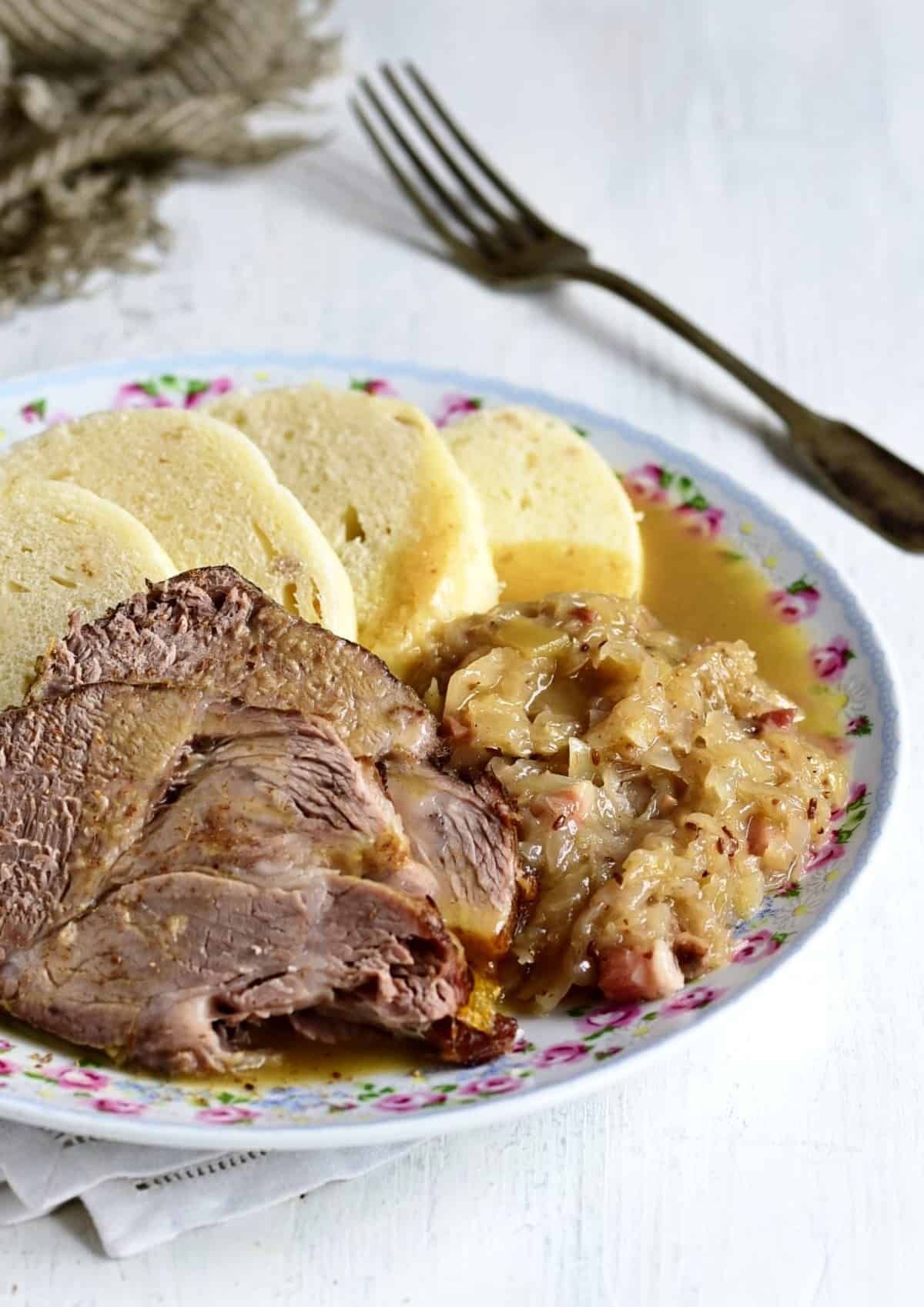
➜ What Is Vepro knedlo zelo?
Literally translated, vepřo knedlo zelo is an abbreviation for Czech roast pork, dumplings, and sauerkraut. This trio is served warm on one plate, poured with flavorful gravy.
Going into details, it's a slowly roasted piece of pork shoulder, bountifully spiced with crushed garlic and caraway seeds. Sliced bread dumplings and braised sauerkraut are served as a side dish. The gravy is made from juices and fat, remaining in a pan after roasting the meat.
In this post, you’ll learn how to make pork roast (vepřo). Here you’ll find separate recipes for BREAD DUMPLINGS (knedlo) and BRAISED SAUERKRAUT (zelo).
MY TIP: Sometimes, this Czech national dish is called knedlo vepřo zelo; the names of the individual components are placed in a different order.
➜ Ingredients
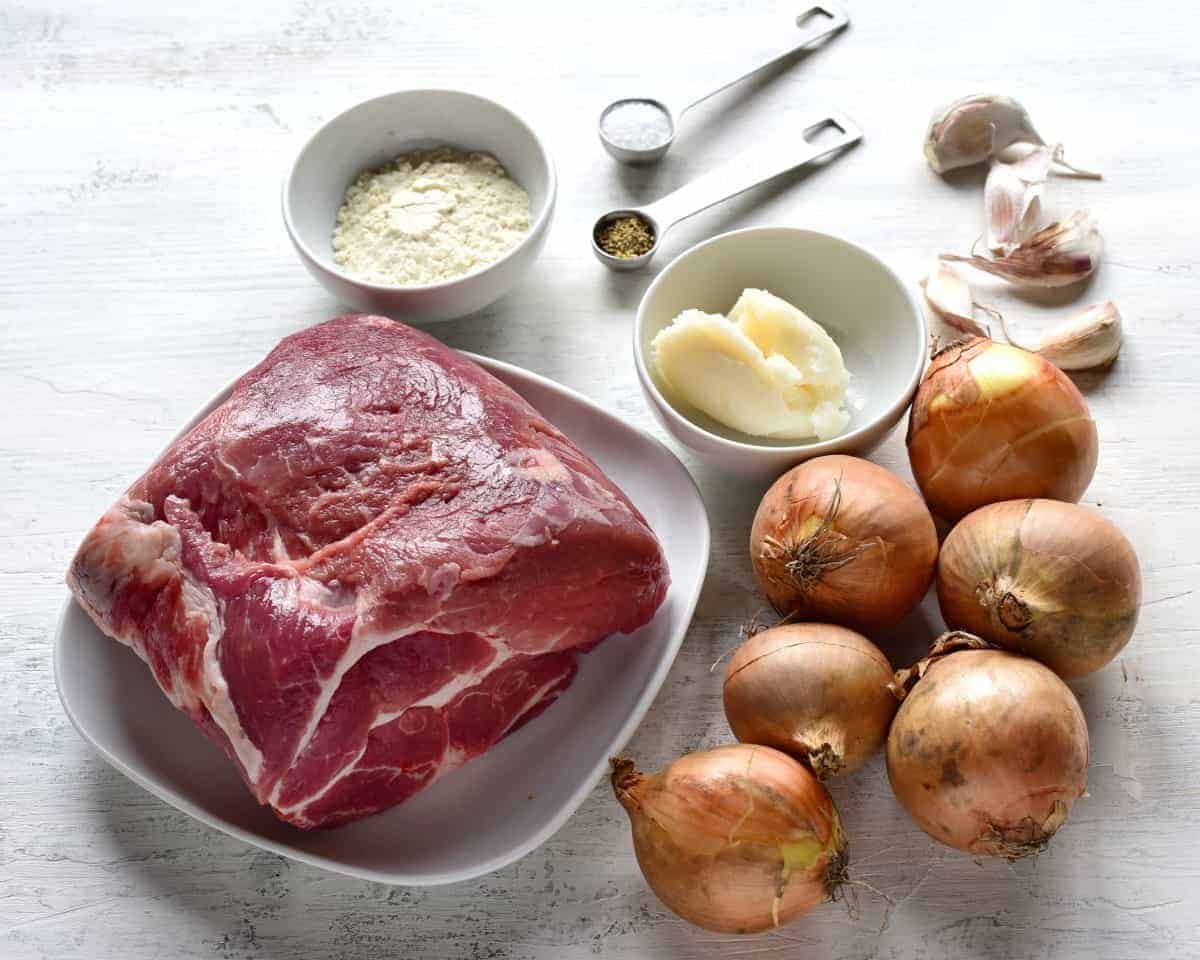
Here is what you need for the VEPŘO part of this recipe:
- Pork shoulder; roasted in one piece. I used a pork collar (krkovice in Czech).
- Onions; peeled and chopped finely
- Cloves of garlic; peeled and pressed
- Pork lard; or vegetable oil like canola or sunflower
- Caraway seeds; crushed – do not confuse caraway with cumin; caraway is a spice used frequently in Czech gastronomy. Also, learn how to grind spices by hand (no mortar and pestle necessary).
- All-purpose flour; to thicken the gravy
- Salt, ground pepper
- Water; as much as you need, about 3 cups – 720 ml
✅ You’ll find the exact amount of ingredients below in the recipe card, which you can also print out.
➜ Instructions with Photos
STEP 1: Preheat the oven to 320 °F (160 °C). Cut the onion roughly. Peel the cloves of garlic and press them.
STEP 2: Salt the meat generously. Dust it with pepper and crushed caraway seeds from all sides. Then rub the pressed garlic onto the pork.
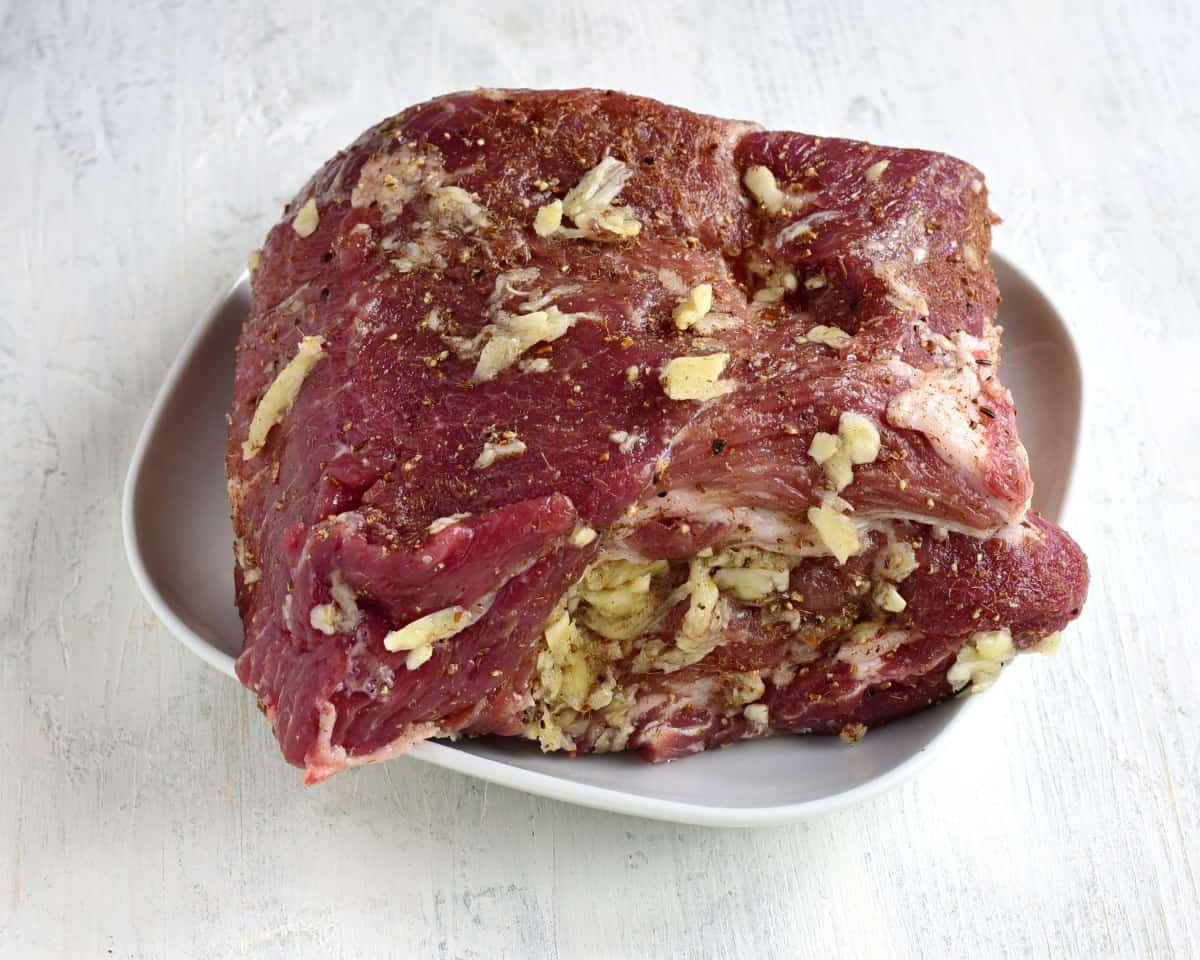
STEP 3: Grease a roasting pan with lard. Pour the onion over the bottom of the pan. Place the seasoned meat on the onion. Pour in 1 cup of water.
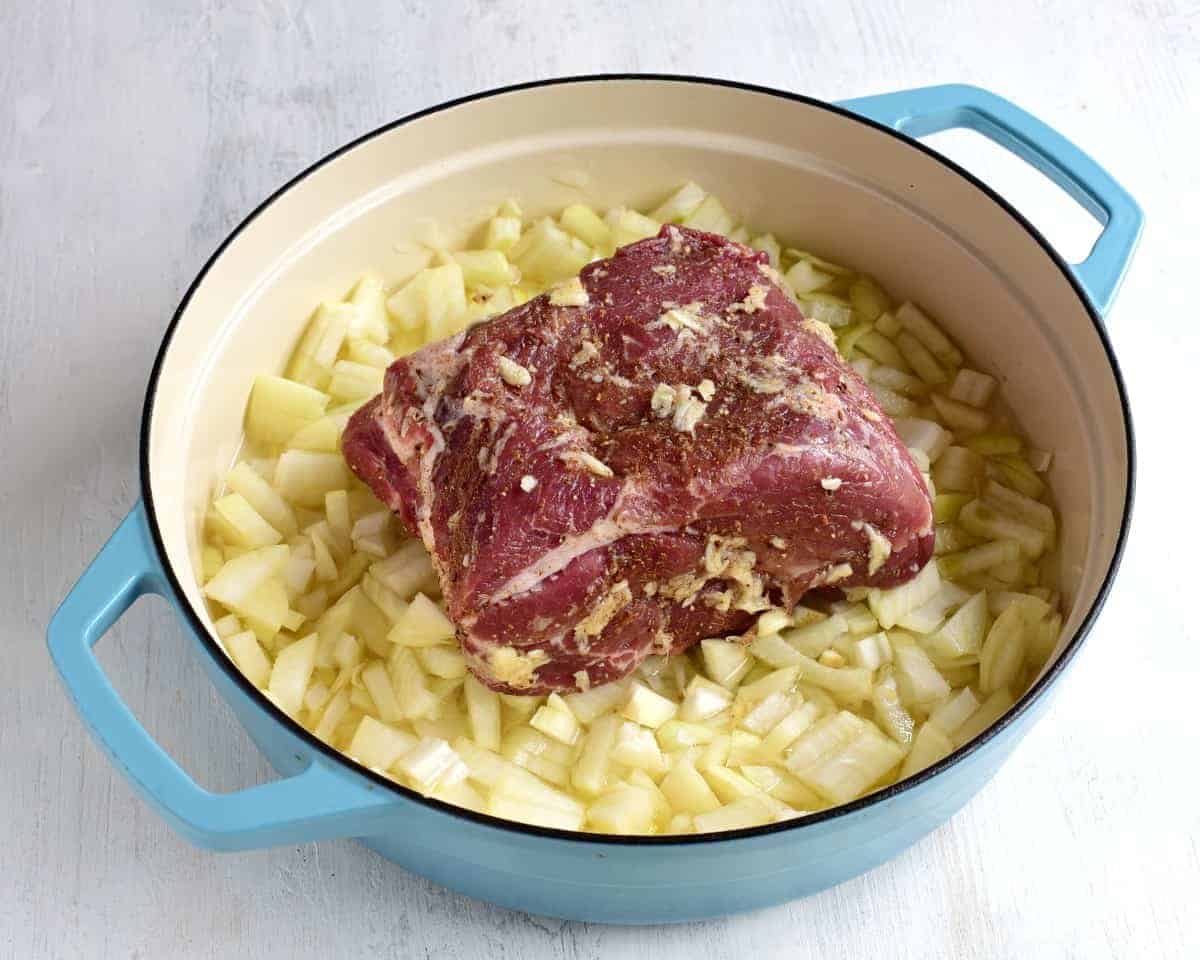
STEP 4: Roast the pork uncovered for 2-2.1/2 hours or until soft. Flip the meat from time to time so that it has a nice brown color over the whole surface. Also, stir the onion occasionally to prevent it from burning. If all the water evaporates, add 1/3 cup more.
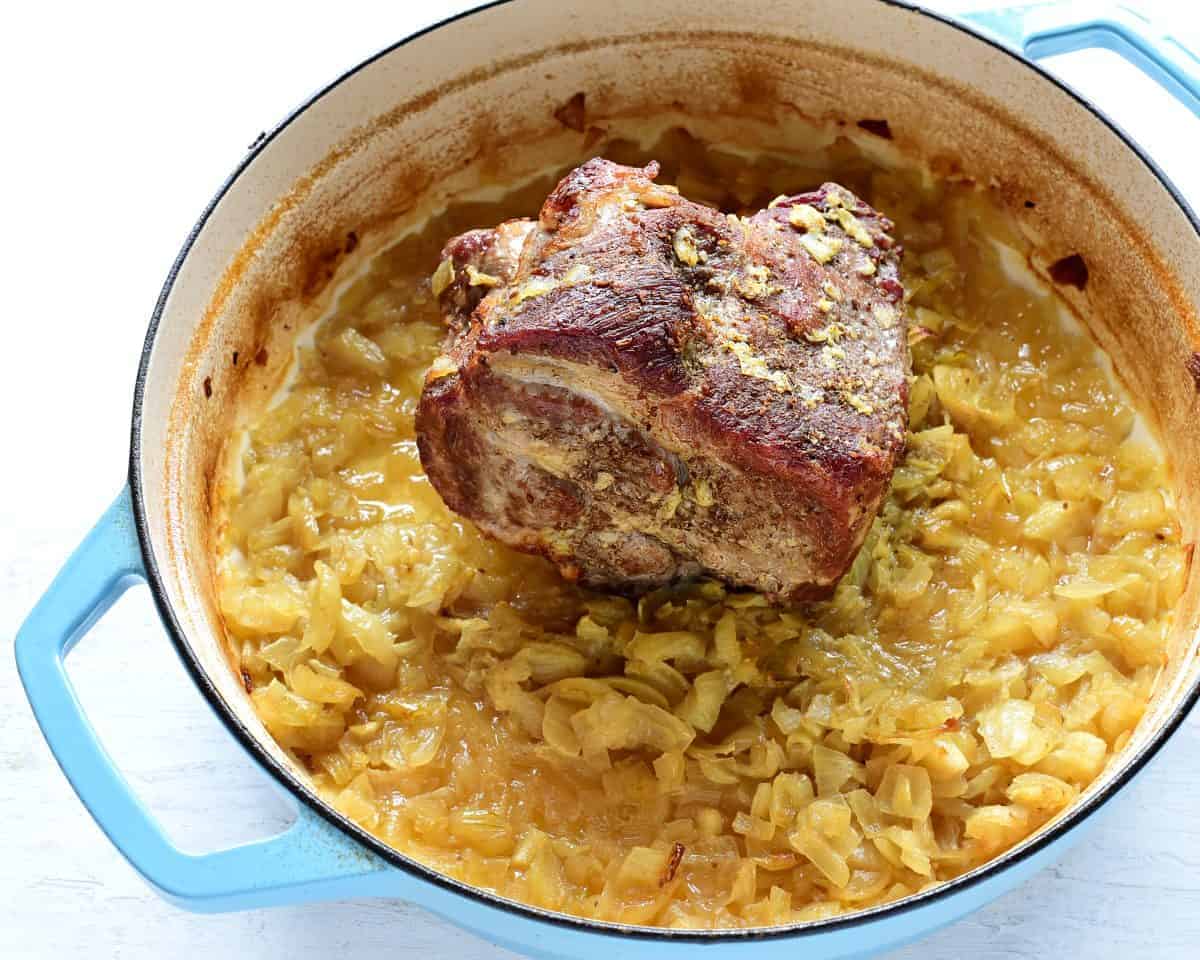
STEP 5: Transfer the roasted meat to a clean plate, cover with foil, and keep it warm.
➜ Making Gravy
STEP 6: Place the uncovered roasting pan with the onion on the stove over medium heat. Reduce the juices to a necessary minimum, and stir occasionally.
STEP 7: Add 1 tablespoon all-purpose flour and fry for 1 minute while stirring, preferably with a flat spatula; it helps you scrape the bottom of the pan to avoid burning flour.
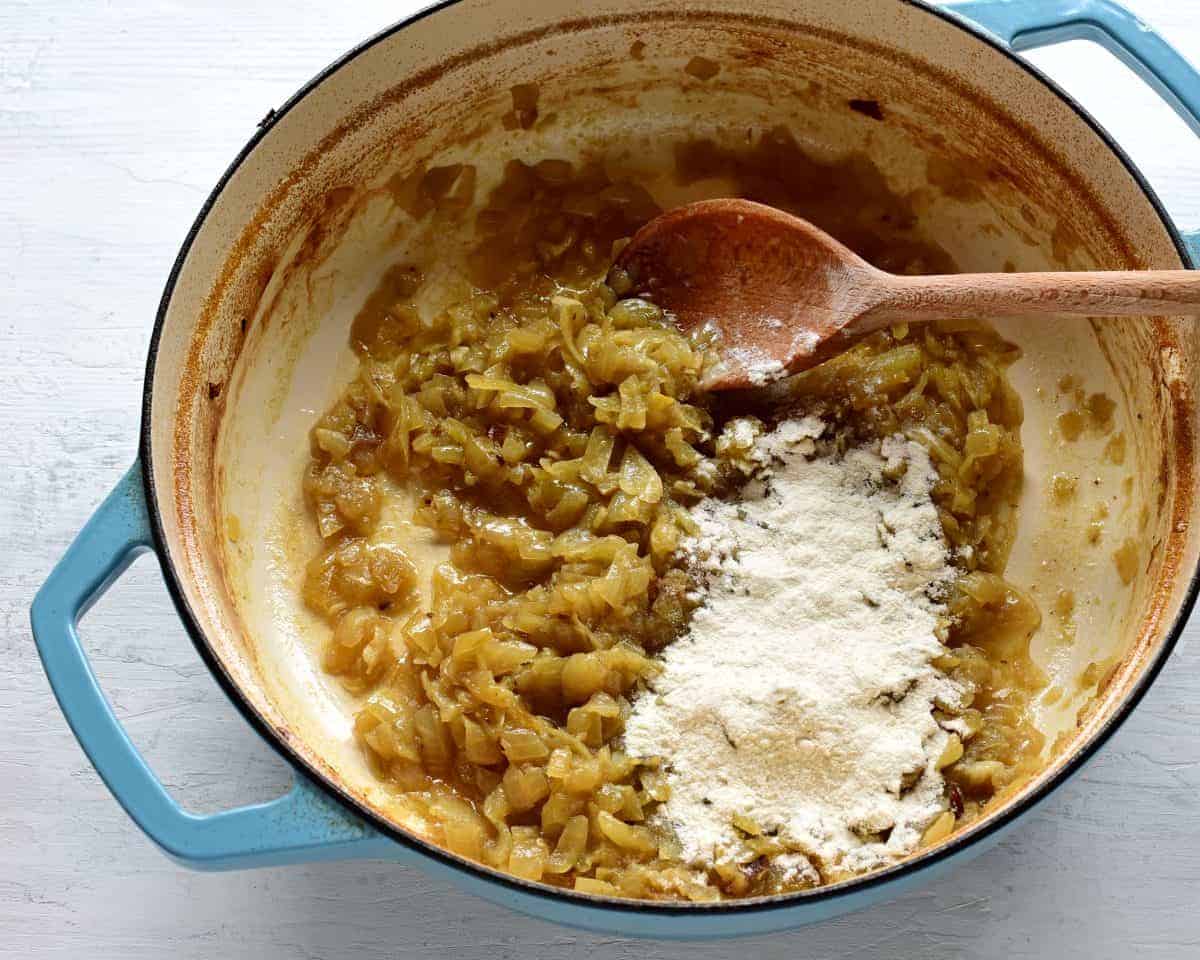
STEP 8: Pour in 2 cups of water, stir well, and bring to a boil. Reduce the heat to 1/3 and let the gravy simmer for 20 minutes.
STEP 9: Strain the gravy through a sieve—season with pepper and salt to fit your taste.
If the gravy's flavor is not strong enough, pour it into a pan, bring it to a boil, and reduce the amount of liquid. You'll boost the taste of the gravy significantly.
➜ Serving
Our task now is to arrange a slice of roasted pork, braised sauerkraut, and sliced dumplings on a plate nicely. Here we go.
- Let’s start with sauerkraut. Place 2-3 tablespoons of warm braised sauerkraut (ZELO) on the side of a plate.
- Add slices of bread dumplings (KNEDLO). Arrange them along the edge, partly covering each other.
- Cut pork roast (VEPŘO) into about ½-inch slices, and add one or two slices on a plate, with the crust side up.
- Pour the gravy over the pork roast and braised sauerkraut.
Enjoy your meal with a lovely Czech beer!
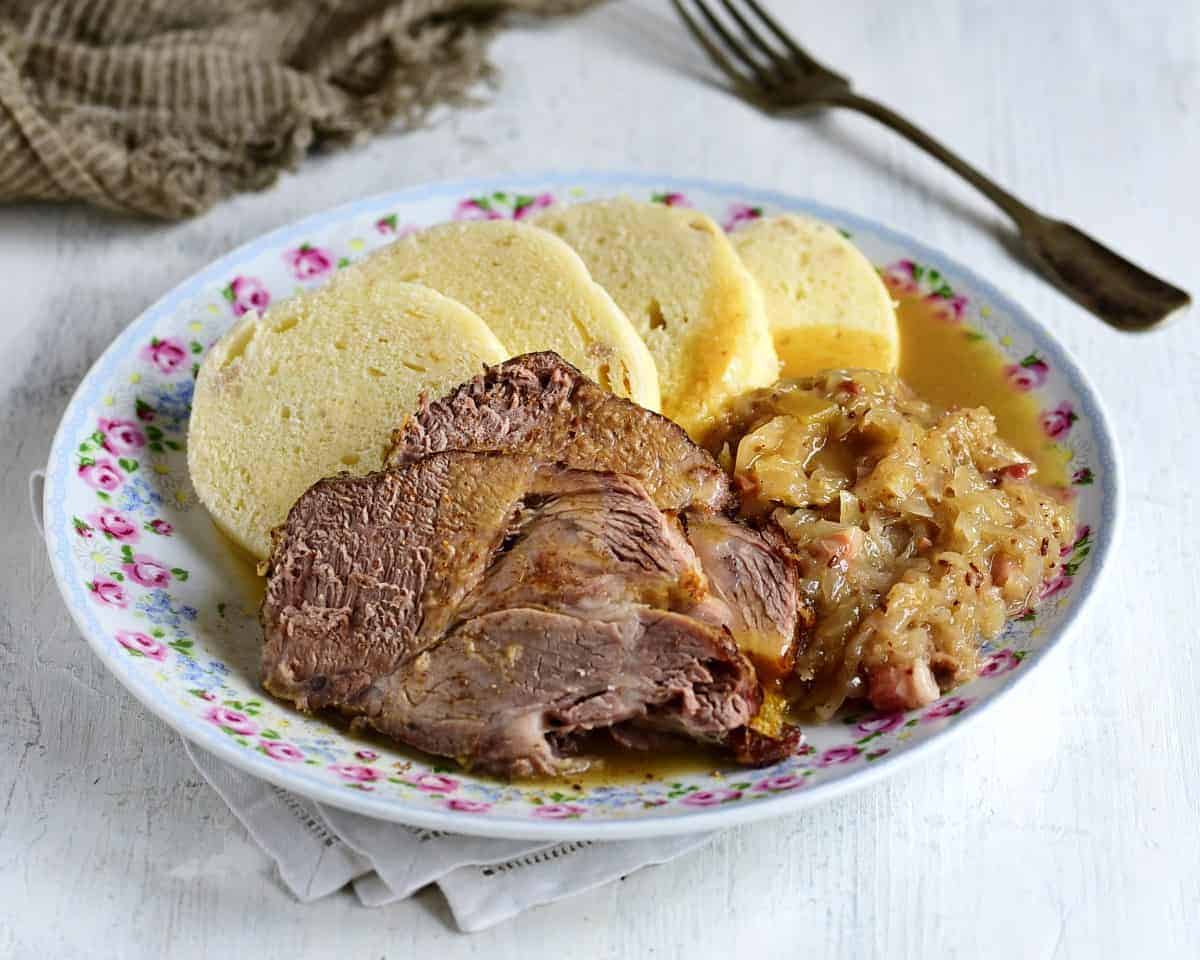
➜ Best Meat for Vepro
You already know that the part "vepřo" means pork (in Czech, it is pork "vepřové maso").
The best pork for this dish is pork shoulder. Pork shoulder is marbled with fat and is ideal for slow roasting. The finished roast will be tender and pretty juicy. Not so dry, like it would be if we'd used too much lean pork.
Another popular Czech dish made with pork is Szegedin goulash.
➜ Pronunciation
Curious how Czechs pronounce "vepřo knedlo zelo"? I recorded a short audio clip to give you an idea! I'm a native speaker, so I guarantee an authentic Czech voice. Attention to the letter Ř 😉
➜ Cook's Tips
- Do not confuse caraway seeds with cumin. Caraway is a typical Czech spice used very often in Czech cuisine.
- You can cover the pan with a lid to speed up the cooking at the beginning of roasting. Remove the lid after 30 minutes and allow the roast to get a nice brown crust.
More classic Czech dishes:
- Svickova – braised beef with cream
- Rajska sauce – sweet tomato gravy
- Beef goulash – Czech hovezi gulas
- Oven-roasted pork shoulder – veprova pecene
- Oven-roasted pork belly bites – veprove vypecky
- Leftover pork roast spread – pomazanka z veprove pecene
Here you’ll find more cherished Czech recipes
Tried this recipe?
Leave a review down in the comments! ⭐⭐⭐⭐⭐
Follow me on Facebook and Pinterest. Subscribe to my newsletter. Send me any question about Czech cuisine to my e-mail. I love hearing your feedback!
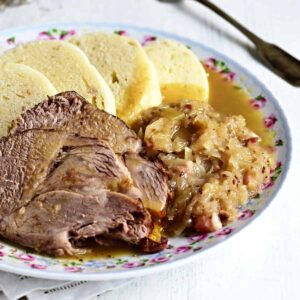
Vepřo Knedlo Zelo
Ingredients
- 2 pounds pork shoulder (900 g) e.g. pork collar
- 6 onions
- 5 cloves garlic
- 1 Tablespoon pork lard or vegetable oil – Canola, Sunflower
- 1 teaspoon caraway seeds crushed
- 1 Tablespoon all-purpose flour
- salt
- pepper ground
- water about 3 cups - 720 ml
Instructions
- Preheat the oven to 320 °F (160 °C). Cut onion roughly. Peel cloves of garlic and press them.
- Salt the meat generously. Dust it with pepper and crushed caraway seeds from all sides. Then rub the pressed garlic onto the pork.
- Grease a roasting pan with lard. Pour the onion over the bottom of the pan. Place the seasoned meat on the onion. Pour in 1 cup of water.
- Roast the pork uncovered for 2-2.½ hours or until soft. Flip the meat from time to time, that it has a nice brown color over the whole surface. Also, stir the onion occasionally to prevent it from burning. If all the water evaporates, add ⅓ cup more.
- Transfer roasted meat to a clean plate, cover with foil, and keep it warm.
Making gravy:
- Place the uncovered roasting pan with onion on the stove over medium heat. Reduce the juices to a necessary minimum. Stir occasionally.
- Add 1 Tbsp all-purpose flour and fry for 1 minute while stirring, preferably with a flat spatula; you can scrape the bottom of the pan to avoid burning flour.
- Pour in 2 cups of water, stir well, and bring to a boil. Reduce heat to ⅓ and let the gravy simmer for 20 minutes.
- Strain the gravy through a sieve—season with pepper and salt to fit your taste.
- Serve warm: a slice of pork roast, braised sauerkraut, and sliced dumplings. Pour the gravy over the meat and sauerkraut.
Notes
- Makes 4 yields.
- If the gravy's flavor is not strong enough, pour it into a pan, bring it to a boil, and reduce the amount of liquid. You'll boost the taste of the gravy significantly.
- The best pork for this dish is pork shoulder. Pork shoulder is marbled with fat and is ideal for slow roasting.
- Do not confuse caraway seeds with cumin. Caraway seeds are a typical Czech spice used very often in Czech cuisine.
- You can cover the pan with a lid to speed up the cooking at the beginning of roasting. Remove the lid after 30 minutes and allow the roast to get a nice brown crust.
DISCLAIMER: Because I come from Central Europe, my recipes are based on metric units such as grams or milliliters. Check out how I convert metric units to the U.S. system:
Conversion chart

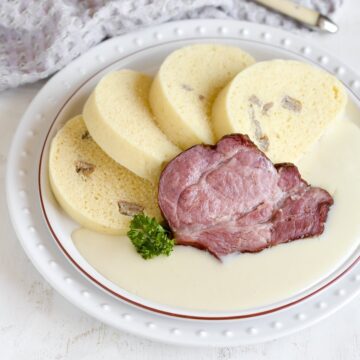

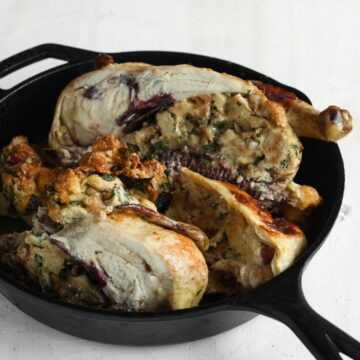
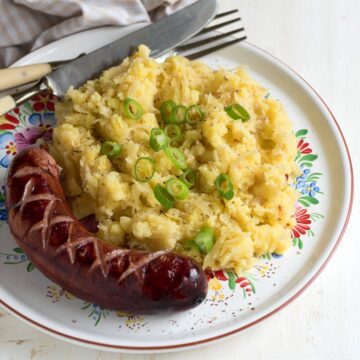
Daniela
Petra — the pork roast was delicious. And so was the gravy. I made along with your sauerkraut recipe but that was served with my mom's recipe for Chlupaty Knedliky (do you know that recipe?). I made it all for our potluck at church and it was all delicious and a big hit 🙂 Thank you for another great recipe and easy to follow instructions.
Petra Kupská
Ahoj Daniela, thank you for your kind words and I am so glad that this Czech classic food tasted good! "Chlupaté knedlíky" are a great choice as a side dish to "knedlo vepřo zelo". I know them and also make them from time to time. I cook chlupaté knedlíky with fresh potatoes, and I am happy to share the recipe, too: https://cooklikeczechs.com/potato-dumplings-czech-chlupate-knedliky/
Best wishes, Petra 🙂
Adrian
Recipe worked out great! Wonderful dish and instructions. Thank you for sharing!
Petra Kupská
Thank you, Adrian, for your lovely feedback! Happy to hear it 🙂
C Cahak
Hello from the USA Petra. Thank you so much for posting this recipe. I am half Czech and am trying to embrace my heritage. My father recently mentioned wanting "Klenicky Zeli" that my grandmother made. Thanks to you I now know it is actually Knedlicky Zeli. I have all my ingredients and am preparing this for tonight's supper.
Petra Kupská
Hello from Bohemia! 🙂 Yes, I believe the word "klenicky" that your father mentioned means really Czech dumplings (knedlicky or knedliky). The combination of dumplings, braised cabbage, and pork roast is one of the Czech classics. Let me know how successful the recipe was, I am curious! Have a nice day, Petra
C Cahak
Almost forgot to get back to you. The dumplings turned out great. I can't wait to make this again. I am so happy to have found your recipe. Thank you so much
Petra Kupská
Thank you very much for your feedback, I appreciate it! At the same time, I am happy that the recipe was a success 🙂
Susan
After searching many Czech recipe sites I found yours and read your story. It warmed my heart. Your recipes are perfect for our Christmas dinner here in Tennessee in the United States. Our son served 2 years as a missionary in your country several years ago and this was the meal he wanted for Christmas this year. The family is so excited to experience the Czech Cuisine, as he has talked about the wonderful food since he has been home. Thank you for sharing your family story and your recipes, I will visit your blog again for other delicious recipes.
Petra Kupská
Thank you, Susan, for your nice words! I am happy you like Czech cuisine. No wonder, Czech dishes are amazingly delicious! 🙂
Rebecca
Just want to say I made this recipe and many more from your blog last week and everything turned out really well! I'm doing a cooking challenge where I cook dishes from every country in the world and your blog was very helpful for Czech week. Thank you so much for taking the time to write these recipes in a format that is easy to follow, and also for the pronunciation because otherwise I'm sure I would be butchering the name of every dish. I won't spam your comments with a link but if you are interested in reading about how Czech week went, my blog is called The Flavor Vortex.
Petra Kupská
Rebecca, thank you very much for your kind words, and of course, I went straight to your website! I am pleasantly surprised; you did a wonderful job, and all of the dishes appear authentically Czech. The veka bread and chlebicky sandwiches in particular caught my eye immediately and made me drool! I left a comment on your website; hopefully, you can find it 🙂 Keep cooking and best wishes from the Czech Republic!
M West
Magnificent, extraordinary, excellent!
This was my first time trying Czech food. I was so excited, it came out so nice! I never used caraway before and had to buy it special. I was scared when I smelled it, very strong and licorice like. But when it was done cooking, all the flavors went together so well. Also my first time steaming bread. I only had all-purpose flour, but don't worry, it was still great. Thank you for this recipe. Also thank you very much for the pronunciation recording. I HATE having to tack on a question mark when I tell my family what I'm making for dinner. Now I can say what I'm making with confidence. Definitely coming back.👌😁❤️
Anicka Cooklikeczechs.com
Thank you for your kind comment. I'm so glad your cooking efforts paid off! It's great that you're using pronunciation recordings and adding authenticity that way too.
I hope you find any future Czech recipes to your liking as well! 🙂
Daniel
Made this today for my Czech partner of 12 years. Very proud of myself that the potato dumplings were such a success. All this time I’ve never dared to attempt them! Also, as an English reader, thanks for making the measurements also accessible for us Europeans!
Petra Kupská
Thank you, Daniel, for your kind words and such nice feedback!